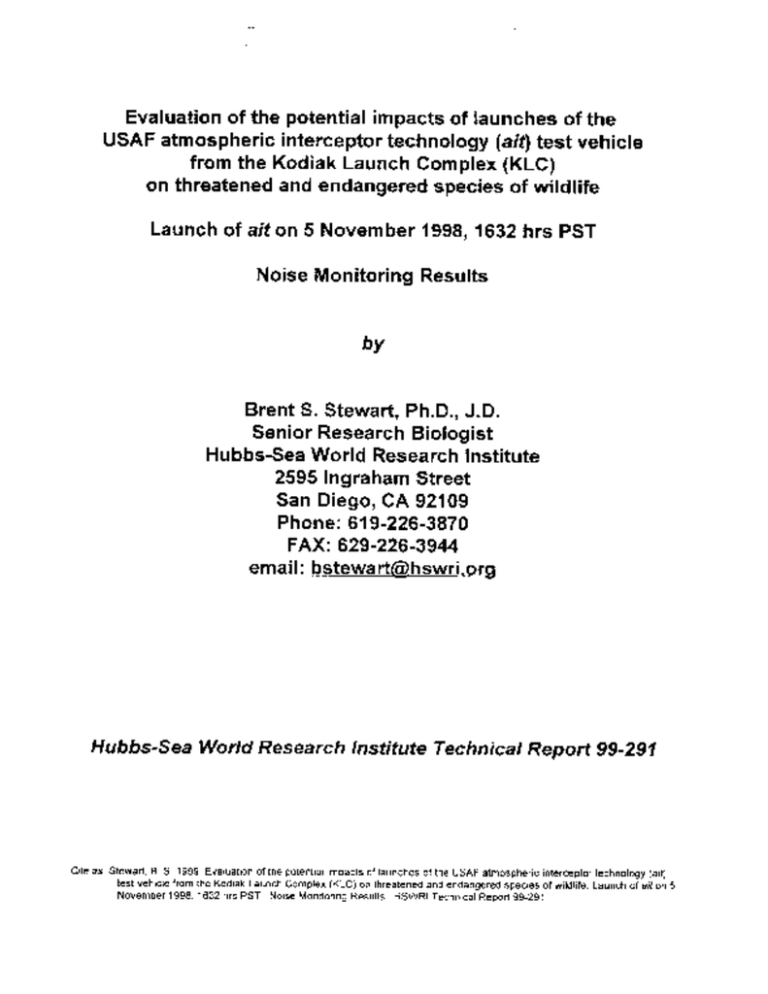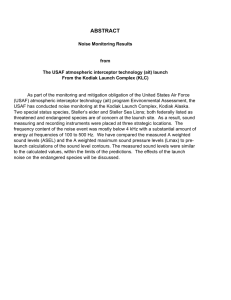Document 11650684
advertisement

ABSTRACT Noise Monitoring Results from The USAF atmospheric interceptor technology (ait) launch From the Kodiak Launch Complex (KLC) As part of the monitoring and mitigation obligation of the United States Air Force (USAF) atmospheric interceptor technology (ait) program Environmental Assessment, the USAF has conducted noise monitoring at the Kodiak Launch Complex, Kodiak Alaska. Two special status species, Steller’s eider and Steller Sea Lions; both federally listed as threatened and endangered species are of concern at the launch site. As a result, sound measuring and recording instruments were placed at three strategic locations. The frequency content of the noise event was mostly below 4 kHz with a substantial amount of energy at frequencies of 100 to 500 Hz. We have compared the measured A weighted sound levels (ASEL) and the A weighted maximum sound pressure levels (Lmax) to prelaunch calculations of the sound level contours. The measured sound levels were similar to the calculated values, within the limits of the predictions. The effects of the launch noise on the endangered species will be discussed. Evaluation of the potential impacts of launches of the USAF atmospheric interceptor technology (ait) test vehicle from the Kodiak Launch Complex (KLC) on threatened and endangered species of wildlife Launch of ait on 5 November 1998, 1632 hrs PST Noise Monitoring Results An "atmospheric interceptor technology" (ait) test rocket was launched at Kodiak Island, Alaska from the Kodiak Launch Complex (KLC; 57°27.118'N, 152°20.520'W) at 1632:00 hrs (PST) on 5 November 1998. The following is a summary of the sound measurments made by a collaborative research team of Hubbs-Sea World Research Institute (HSWRI; B.S. Stewart), the Environment and Natural Resources Institute (ENRI) of the University of Alaska (S. Cucarese), and the United States Air Force (T. Huynh and V. Lang). Sound measuring and recording instruments were placed at three sites within several miles of the launch pad (Table 1, Figure 1): 1. A digital audio tape recorder (TEAC Tascom DAT) with an ACO 7013 microphone (flat response from 5 Hz to 20 kHz) was operated by Stewart at the launch Azimuth site (57°26.976'N, 152°19.580'W). The recorder was activated approximately 1 hour before the scheduled launch time and recorded continuously through the launch. The microphone was calibrated just before and just after launch. 2. Two Larson-Davis sound level meters (SLMs) were installed on the ocean bluff at the northeast side of Narrow Cape (57°25.919'N, 152°19.195'W). A Larson-Davis 820 SLM was set to make fast (125 millisecond exponentially weighted time averaging), C-weighted sound measurements whereas a LarsonDavis 870/875 SLM was set to make slow (1 second exponentially weighted time averaging), A-weighted sound measurements. The SLMs were set to record sound events when noise thresholds exceeded 65 dBA (870/875) or 65dBC (820). They were retrieved and calibrated just after launch on 5 November. 3. Two Larson-Davis sound level meters (SLMs) were also installed at 1050 on 4 November on Cite as: Stewart, B S. 1999. Evaluation of the potential impacts of launches of the USAF atmospheric interceptor technology (ait) test vehicle from the Kodiak Launch Complex (KLC) on threatened and endangered species of wildlife: Launch of ait on 5 November 1998. 1632 hrs PST: Noise Monitoring Results HSWRI Technical Report 99-291. 9 the just above the beach at the northern spit at Ugak Island (57°23.53'N, 152°17.307'W; Figure1), a seasonal haul out for Steller sea lions (Eumetopias jubatus). No sea lions were present during the observation period. A Larson-Davis 820 SLM was set to make fast (1/8 second exponential time averaging), C-weighted sound measurements whereas a Larson-Davis 870/875 SLM was set to make slow (1 second exponential time averaging), A-weighted sound measurements. The SLMs were set to record sound events when noise thresholds exceeded 65 dBA (870/875) or 65dBC (820). The SLMs were retrieved and calibrated just after launch on 5 November. The memory in the Larson-Davis 820 filled up prior to launch, evidently due to excessive surf, and perhaps wind, noise centered at relatively low frequency which had a greater triggering effect on this instrument owing to the more sensitive monitoring settings (i.e., fast, C-weighting). The definition, measurement and analysis of noise and noise impact has historically been anthropocentric. Consequently, such anthropocentric noise metrics that are generally reported concentrate on sound energy or sound pressure values that are thought to be most relevant to human auditory sensitivity function. For continuous noise, like rocket launch noise, the important variables relevant to assessing auditory impacts or behavioral response are intensity, frequency spectrum, and duration of the noise. The most common metrics calculated for noise exposure effects on humans or human-made structures are sound exposure level (defined as A-weighted = ASEL), maximum unweighted sound pressure level (LmaX) or sometimes overall sound pressure level = OASPL) and A-weighted sound pressure level ( Lamax). The noise is generally discounted by the extent of contribution by frequencies less than 1 kHz and greater than 6 kHz (= A-weighting). Applying an A-weighted filter to most rocket launch noise discounts the loudness of that noise considerably (Figure 2), relative to the apparent sensitivity of the human auditory system, because it generally consists of substantial low frequency (i.e., less than 1 kHz) sound pressure. C-weighting deemphasizes low frequency components of less than about 50 Hz (Figure 2). The Larson-Davis sound level meters (SLMs) measure instantaneous sound pressure levels at 32 millisecond intervals. The greatest of such sound pressure levels that are recorded during a specific period of time is designated as the peak sound pressure level, further qualified according to whether it is a weighted or unweighted measure. Maximum (unweighted or weighted; i.e. Lmax, or OASPL, and Lamax respectively) sound pressure levels for a noise event are determined as the greatest of averages of root Cite as: Stewart. B. S l 999 Evaluation of the potential impacts of launches of the USAF atmospheric interceptor technology (ait) test vehicle from the Kodiak Launch Complex (KLC) on threatened and endangered species of wildlife: Launch of ait on 5 November 1998. 1632 hrs PST: Noise Monitoring Results. HSWRI Technical Report 99-291 mean square instantaneous sound pressure levels measured during either 125 millisecond (fast time averaging) or 1 second (slow time averaging) periods. The sound exposure level (ASEL; defined as Aweighted) is a measure of the cumulative energy in a noise event. It is time weighted average level plus 10 times the logarithm (base 10) of the measurement time in seconds. For detailed definitions see: American National Standards Institute. 1994. American National Standard Acoustical Temminology. ANSI S1.1-1994. Standards Secretariat, Acoustical Society of America, New York: 47pp. No standards have yet been established by regulatory agencies for assessing the impacts of anthropogenic sound on the behavior or auditory physiology of wildlife, though A-weighted sound exposure level and maximum sound pressure level measures (as indicated above, anthropocentric measures which place most importance on sound between 1 kHz and 6 kHz) have been consulted in past environmental impact assessment processes. Whether auditory systems of marine mammal and bird species of concern near Kodiak Island respond to various noises like the human ear may is not well known. Indeed, these animals may be more sensitive to low frequency sounds their auditory systems may integrate sound differently than the human ear. Consequently, unweighted, C-weighted and peak (generally thought to be relevant only to impulse noise exposure in humans) measures may be more appropriate for analyses. In any event, I include several measures here for comparative reference. Most of the sound energy that impacted the Azimuth site occurred within 20 seconds after launch though some noise was audible above background levels for a total of about 59 seconds (Figure 3, Table 1). The frequency content of that noise was mostly below 4 kHz (Figure 4, 5) with a substantial amount of energy at frequencies of 100 to 500 Hz (Figure 5). The sound exposure level (ASEL) for the noise event was 110 dBA and the maximum sound pressure level (LAmax) was approximately 104 dBA, both slightly higher than predicted for the aft rocket motor at that distance from the launch pad (cf. Figure 6). The spectral characteristics of noise impacting the other two monitoring sites were similar to the Azimuth site noise, with most energy below 4 kHz and centered at around 100 to 500 Hz. The sound exposure levels and maximum sound pressure levels recorded at those sites (Table 1 ) were also several decibels greater than the pre-launch predictions (Figure 6). The few available data for hearing thresholds in eared pinnipeds (family Otariidae) and birds indicate that the launch noise would have been detected by local bird and pinniped fauna and that those Cite as: Stewart. B. S. 1999 Evaluation of the potential impacts of launches of the USAF atmospheric interceptor technology (ait) test vehicle from the Kodiak Launch Complex (KLC) on threatened and endangered species of wildlife: Launch of ait on 5 November 1998 1632 hrs PST: Noise Monitoring Results HSWRI Technical Report 99-291 -4- species likely would have responded behaviorally to the launch noise event impacting the three monitoring sites. No data are available on hearing abilities of Steller sea lions, though the few available data for the California sea lion (Zalophus californianus) indicate that in-air hearing thresholds are about 18 to 30 dB (re: 20 m pa) between 1 and 4 kHz, respectively (see, e.g., Figure 7A). Data for one California sea lion suggest an in-air hearing threshold of around 77 dB (re: 20 m Pa) at 100 Hz. If hearing abilities of Steller sea lions are similar, then most of the launch noise that was recorded would have been audible to sea lions that may seasonally haul out at Ugak Island. Hearing impairment of sea lions exposed to this short duration noise event would not be likely, though sea lions would likely alert to and perhaps be stimulated to move towards or into the surf by these unique noises. The same conclusions would apply to Steller's eiders and bald eagles in the near vicinity (cf Figure 7B). Whether the predicted behavioral responses of affected marine mammals or other federally protected species would rise above the textual standard of harassment" as statutorily defined, and thereby require an incidental harassment permit, has not been made clear by the controlling regulatory agencies. Such lack of clarity makes it difficult to predict the outcome of challenges to regulatory agency discretion in allowing disturbance to Steller sea lions, in particular. Consequently, the request and issuance of an incidental harassment permit would perhaps be the best strategy to ensure that future launch missions at KLC are not interrupted or that the risk of imposition of criminal penalties are avoided following a launchrelated disturbance event. The former is primarily an issue for missions other Air Force contracted launches as only one ait mission remains. The issuance of such a tactical permit to the U.S. Air Force for the remaining ait may clearly, however, establish a precedent for the strategic long-term operation of the KLC facility which will evidently primarily support space launch vehicles larger than the ait. Consequently, an umbrella permit to the KLC operator, the Alaska Aerospace Development Corporation, for general launch activities would provide insurance that the long term integrity of launch missions would not be interrupted owing to concerns about noiserelated impacts to wildlife. There would seem to be no substantive nor procedural barriers to issuance of either a general permit to AADC nor a single event permit to the Air Force for KLC launches. Cite as: Stewart, B. S 1999. Evaluation of the potential impacts of launches of the USAF atmospheric interceptor technology (ait)) test vehicle from the Kodiak Launch Complex (KLC) on threatened and endangered species of wildlife: Launch of ait on 5 November 1998. 1632 hrs PST; Noise Monitoring Results HSWRI Technical Report 99-291



